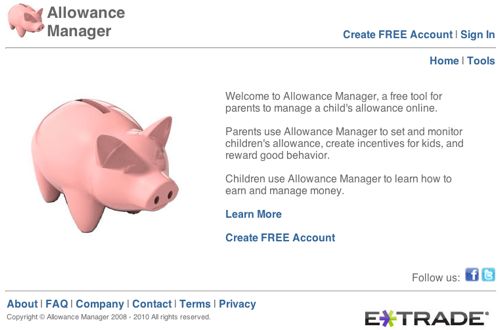Mark and I have discussed starting an allowance for Emily, and we’re still in the process of experimenting with exactly what process will work best for us. However, there is a great new site that helps manage your child(ren)’s allowance — allowancemanager.com which I was recently asked to review.
Giving Emily an allowance would help her to understand the value of money, reward good behavior, encourage her to complete her chores each week, and introduce her to the concept of saving (among other things). I was intrigued by what tools allowancemanager.com had to offer.
You can create an account for free on allowancemanager.com and the tools are simple and easy to use. Create separate accounts for each child, and enter their weekly allowance rates. You can easily add entries for gifts, donations, cash withdrawals, or investments to keep your child’s account up to date. I personally love the printable chore chart that is available in the Tools section. I look forward to using the site more, and I think Emily will enjoy logging in once in awhile to check the progress on her account!
Since we’re relatively new to the world of allowances, I would love to hear your thoughts on this — How do you handle allowances? What systems do you use? Have you found a system that works well for your family? Leave a comment on this post and share your stories with us!
Disclosure — In exchange for posting this review, I was given a $20 Target giftcard (Yay, Target!!)










The Simple Dollar blog has some posts on kids’ allowances. If I recall correctly, the amount is commensurate with the child’s age, and Trent has his kids divide their allowances into fourths: spending money, saving for a goal (a desired toy), charity, and long-term savings (i.e. not to be touched).
I believe there’s even a physical piggy bank available somewhere with these or similar divisions built in.
That is really good to know! I like how Trent has the kids divide their allowance money up like that — good practice for later on.
Perfect timing, we are trying to figure out allowance for Abby as well. I’ve tried it before, but it only lasts a day or two.
I’m going to have to mark it on the calendar, or I’ll forget too!
So funny, I just posted on this topic today. I think my son is more responsive to being able to see, feel and count his money than he would be to tracking it on the computer, but this looks good for when he is older.
I’m off to check out your post — you know what they say about great minds! 😉
We started an allowance for our 4 year old as a math lesson more than anything else but it’s been a positive step here. He has three Mason jars labeled “Save”, “Spend”, and “Give”. He gets $3 every week and puts $1 into each jar.
He also has a kids savings account at the local bank so he’s learning a little about earning interest when he makes his deposits there from the money he’s accrued in his “Save’ jar.
The biggest lesson that he has learned so far is that shopping at thrift stores is hugely preferable to him than shopping at Target because he can afford things more quickly at the thrift store. That is not a lesson that I have been easily able to reinforce when I was using my money rather than his own.
He is able to choose where to donate his “Give” dollars. So far, he prefers to drop them in the box at the Museum of Natural History which is a favorite free haunt of ours. He’s welcome to donate to our church too but we really want him to learn about other nonprofit organizations as well.
I should really post about this sometime! Thanks for the idea. I’ll check out the allowance manager too.
That’s fantastic — I especially love that he enjoys shopping at the Thrift store, and that he is able to choose where to donate his “give” dollars. Very cool!!
My children are not even close to the age of allowance (19mo and 4mo) however I have given thought to the idea. I am a fan of children learning how to be responsible with money. I would like to instill the value of saving, looking for a good deal, and then purchasing that special item.
My plan thus far is to have a type of chore chart and each chore is worth a certain amount of money. In order to complete a chore the child would look at the chart (pictures for little ones) and pick what they would like to complete to help them get to their weekly goal. Chore completeness would be approved by mom or dad and then marked with a sticker on the chart. At the end of the week allowance for each chore completed would be given. I’m thinking of starting out pretty cheap with a penny per chore as I am sure the kids will ask for “raises” many times and I do not want to break the bank.
I am, so far, in favor of the kids picking what they would like to complete so they will hopefully learn the concept the more you help around the house the more you will earn. I also agree with Tara (above) about teaching children the concept of Save, Spend, and Give. Allowance is a great learning tool!
Good luck deciding!
Great ideas, Liz!! Your kids are going to grow up to be so money-savvy! It is a great learning tool, and I’m curious how Emily will respond to having her own allowance…. we’ll see!!
My four year old gets an allowance, but it is chore based. Every chore he completes adds money to his allowance. It isn’t much (mostly 10 cents per chore, or a quarter for bigger chores such as putting all his laundry away). It adds up to about $2-$3 per week. My son loves this and loves to see himself earning money which is why we make a bar graph to show him his money going up. Also, if some days he wants to not do some chores, we allow him to do this but remind him that he will not earn the money without doing the work.
Oh, I love the bar graph idea!! What a great visual way for him to track how much he earns!
I’m curious about what chores a 5 yr old can do? What’s on your chore list?
I don’t have a chore list for Emily, but I know several people who keep a system like that for giving out allowances, and she does do a lot to help out around the house. She helps empty the dishwasher, fold towels, match socks, puts away laundry, makes her bed, picks up her toys, and helps me prepare dinner, just to name a few!
This is really thought provoking, I hadn’t really thought about allowances yet, our kids are 4 and 2 but I guess I should! Learning from what ever one else is doing is great.
Thanks for sharing the site too. My husband and I use an online budgeting program so it seems natural to hook the kids up with one as well.
I love hearing about everyone else’s approach to these sorts of things because they can vary so much, and it brings up a lot of points I wouldn’t necessarily think of on my own. The online site is nice because it’s good practice for associating a written number with the physical value — much like a credit card bill. I’ll let you know how it goes!
It’s probably just semantics, but we call it payday, not allowance, for we don’t want to give them the idea they’re getting paid each week just because they’re part of the family. Essentially we tell them the jobs that we expect them to do and how much each job would earn them–similar to what the other moms say about getting paid via the chore chart. Then, as soon as they can write or draw, we have them make us an invoice at a designated time in the week, and we go over it with them.
Oh, I LOVE that you call it payday!!!! And an invoice– you are brilliant!! Thanks so much for sharing this, Heather!
Because I believe that children should participate in chores simply because they’re members of a family team, I don’t pay them for basic chores. Thus, they were expected to make their beds, do a room-tidy chore each day, and help with the dishes once or twice a week, independent of their allowance. However, if they DIDN’T do one or more of the basic chores, their allowance would be reduced accordingly.
After the basic chores, they could add to their allowance by doing extras — yard work, the laundry, cleaning the bathroom, even cleaning up after ME (imagine! mwah-ha).
When they got to their teens, they were given a modest monthly spending allowance. We wrote a contract, different for each child, itemizing what they’d be responsible for, and what I would pay for. So… I’d buy socks, underwear and outerwear, and so many pairs of jeans, shirts, and sweaters each season. I also had a maximum I’d spend on any one item. So, if I could get a perfectly decent pair of jeans for $30, but they wanted the brand du jour for $140, they’d have to cough up the difference. It was entertaining to notice how often they decided it wasn’t worth the premium when it was their own money they were spending!
It was also entertaining to see their dismay the first time they ran through all their money by the middle of the third week, and then couldn’t go to the movies with their friends in week four. I was a seriously Mean Mom when I wouldn’t spot them the cash. But how else do we learn these lessons? Better to learn it with movie money than rent money!
And when they had a part-time job that made them more than $50/week, they didn’t get an allowance at all, though we still abided by a contract of who’s-responsible-for-what.
Phew. I just wrote a post in the comments section…
Mary, this is fantastic!! I’m so glad you shared this — I love that the kids were expected to do basic chores and could add to it, and that you didn’t give in at the end of the month when they had spent all their money and wanted to go to the movies. MUCH better to learn with movie money than with rent money!! And the contract is brilliant! I’m definitely tucking away these gems of ideas for later use… THANK YOU!! xoxo